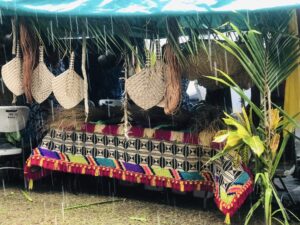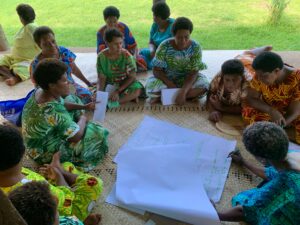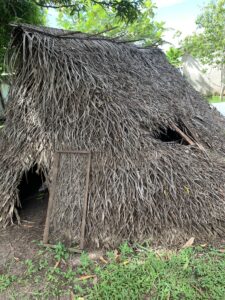Women’s network launches strategic plan, hosts craft show
September 25, 2024
Over the past year, the members of the Cicia Women’s Network have focused on strengthening their governance structure and building sustainable sources of income based on traditional knowledge. Their hard work led to the launch of the network’s 5-year strategic development plan and the successful hosting of a craft show in Suva last month.

Photo credit: Cicia Women’s Network/Merewalesi Vakarewa
The Cicia Women’s Network is made up of urban and rural women who share ancestry from Cicia, a remote island located within the Lau Group in the eastern part of Fiji. The island has 5 villages – Lomati, Mabula, Naceva, Natokalau and Tarakua – with a total population of about 1,000 people. In 2013, Cicia became the first certified organic island in the Pacific, committed to chemical-free agricultural practices.[i] The island’s remote location presents logistical challenges to its inhabitants, with travel options limited to fortnightly or monthly boat trips and weekly flights to Suva, Fiji’s business and administrative centre. Despite these challenges, the women’s network is dedicated to empowering its members through economic and social development, entrepreneurship, leadership and decision-making.
Strengthening women’s leadership and decision-making
As a newly established organisation, Cicia Women’s Network has focused on strengthening its governance structure, formulating policies and developing a strategic development plan. The network draws strength from its rural-urban linkages to help empower the women of Cicia. It also collaborates with larger women’s groups, such as the Soqosoqo Vakamarama iTaukei Cakaudrove, to share best practices in organisational management and exchange learnings.
A key outcome of this work has been the establishment of a dual leadership structure, with women leaders from each of the 5 villages working with their urban counterparts. Through this setup, they aim to hold regular meetings between the rural and urban committees to enhance communication and improve the effectiveness of their projects.
While developing the strategic development plan, the women’s network conducted a situational analysis to identify the needs, resources, knowledge and skills in each of the 5 villages.

‘The first trip was doing resource mapping and data gathering so that we could understand their needs and the skills that we need to enhance…’
Merewalesi Vakarewa,
Cicia Women’s Network’s general secretary
Merewalesi Vakarewa, the network’s general secretary, shared that with the resource mapping work now completed, their next focus is to provide training to address the skills gap they identified and make use of underutilised and untapped resources.
While formulating the strategic development plan, the women’s network worked with stakeholders at different levels to ensure inclusivity and a shared sense of responsibility. The strategic plan focuses on 4 areas:
- Strengthening leadership and good governance
- Inspiring and enhancing tangible and intangible cultural knowledge and skills
- Connecting and empowering women through community economic development and establishing an effective marketing strategy and platforms
- Improving and enhancing resilience effort through climate change justice and adaptation
Investing in women’s economic empowerment and resilience
The Cicia Women’s Network has also been working on establishing and enhancing sustainable income-generating activities, with an emphasis on reviving and preserving traditional knowledge and skills in crafting.

For instance, the villagers have successfully revived the ancient art of making black dye (loaloa) from candlenuts (Aleurites moluccanus), which is used for printing designs on bark cloth (masi) made from mulberry trees. This traditional practice has several steps and some taboos that must be followed. To carry out this activity, the women’s groups in each village have built a small, windowless thatched hut (bure) with the help of male villagers. Only celibate women are allowed to enter the hut, so the work of making loaloa is typically done by the older women and widows in the village. Since this traditional practice is unique to Cicia Island, the women’s network intends to get intellectual property rights to protect it.
Intergenerational learning plays a vital role in the network’s economic empowerment work. Older women are passing down traditional knowledge and skills to the younger generation. Craft work is often carried out communally, following the traditional practice of solesolevaki, where many hands make light work for activities like weaving mats and producing masi and loaloa. Another form of communal work is balebale, where women form small groups of 5 to 10 members and come together on an assigned day each week to help each other in activities such as mat weaving. The individual who benefits from this communal work pays a fee ranging from $5 to $10 to the women’s group.
One of the traditional crafts that the women of Cicia Island are practising is making masi, which is commonly used as ceremonial gifts for important events like births, weddings and funerals. Lewedua Lewai, from Naceva Village, explained the process they follow to make masi. Last year, the 14 women in her village each planted 10 mulberry trees (Broussonetia papyrifera) around their houses. As these plants take about 6 months to mature, they have already harvested the first batch and used it to produce masi, printing designs on it using the loaloa dye. Although they are currently using designs borrowed from the neighbouring island of Nayau, Lewedua shared that they are interested in developing their own designs to reflect their traditional animals and plants. She added that they want to enhance the quality of their masi and scale up production before seeking a market.
The women’s network is also working on revitalising the virgin coconut oil cottage industry on their island. They aim to establish a production house in each village, with a focus on high quality and increased production capacity. While some of the women’s groups have started making and selling virgin coconut oil, finding consistent market access has been identified as a challenge and is something the network aims to address.
Engaging men at the family and community levels is important for the success of women’s economic empowerment work. On Cicia Island, men are contributing through activities such as building production houses, planting mulberry and pandanus trees, and scrapping coconuts. They have also assisted with catering while women participated in workshops and meetings, demonstrating a shift in traditional gender roles within the community.
Ready for the next phase
After dedicating a year to strengthening their organisation and laying the foundation for sustainable income-generating activities, the members of the Cicia Women’s Network are now well-positioned to embark on their next phase of work. With the strategic development plan, they have identified the key priorities and activities to focus on over the next few years to help ensure good governance, enhance cultural knowledge and skills, boost community economic development, and build climate resilience.
About the project
Women’s Fund Fiji (WFF) provides sustainability grants to support programs and projects that enhance gender equality. In June 2023, Cicia Women’s Network received a grant to support their work under WFF’s thematic areas ‘women’s leadership and decision-making’ and ‘women’s economic empowerment’. This project is funded by the New Zealand Ministry of Foreign Affairs and Trade.
________________________
[1] Radio New Zealand, Cicia, Fiji, is the Pacific’s first fully-organic island, RNZ website, 8 July 2013, accessed 29 August 2024.
Recent impact stories
Market Access Made Easy for Cicia Women
September 6 2025
“She Sees Me Play”
June 30 2025
Women Lead Climate Action in Yavusania Village
June 29 2025
A Safe Haven for Women
June 20 2025
From Hive to Harvest
March 16 2025
